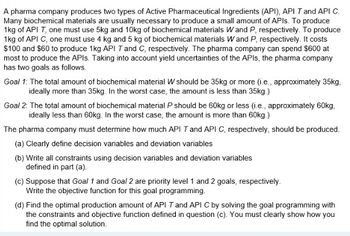A pharma company produces two types of Active Pharmaceutical Ingredients (API), API T and API C. Many biochemical materials are usually necessary to produce a small amount of APIs. To produce 1kg of API T, one must use 5kg and 10kg of biochemical materials Wand P, respectively. To produce 1kg of API C, one must use 4 kg and 5 kg of biochemical materials Wand P, respectively. It costs $100 and $60 to produce 1kg API T and C, respectively. The pharma company can spend $600 at most to produce the APIs. Taking into account yield uncertainties of the APIs, the pharma company has two goals as follows. Goal 1: The total amount of biochemical material W should be 35kg or more (i.e., approximately 35kg, ideally more than 35kg. In the worst case, the amount is less than 35kg.) Goal 2: The total amount of biochemical material P should be 60kg or less (i.e., approximately 60kg, ideally less than 60kg. In the worst case, the amount is more than 60kg.) The pharma company must determine how much API T and API C, respectively, should be produced. (a) Clearly define decision variables and deviation variables (b) Write all constraints using decision variables and deviation variables defined in part (a). (c) Suppose that Goal 1 and Goal 2 are priority level 1 and 2 goals, respectively. Write the objective function for this goal programming. (d) Find the optimal production amount of API T and API C by solving the goal programming with the constraints and objective function defined in question (c). You must clearly show how you find the optimal solution.
A pharma company produces two types of Active Pharmaceutical Ingredients (API), API T and API C. Many biochemical materials are usually necessary to produce a small amount of APIs. To produce 1kg of API T, one must use 5kg and 10kg of biochemical materials Wand P, respectively. To produce 1kg of API C, one must use 4 kg and 5 kg of biochemical materials Wand P, respectively. It costs $100 and $60 to produce 1kg API T and C, respectively. The pharma company can spend $600 at most to produce the APIs. Taking into account yield uncertainties of the APIs, the pharma company has two goals as follows. Goal 1: The total amount of biochemical material W should be 35kg or more (i.e., approximately 35kg, ideally more than 35kg. In the worst case, the amount is less than 35kg.) Goal 2: The total amount of biochemical material P should be 60kg or less (i.e., approximately 60kg, ideally less than 60kg. In the worst case, the amount is more than 60kg.) The pharma company must determine how much API T and API C, respectively, should be produced. (a) Clearly define decision variables and deviation variables (b) Write all constraints using decision variables and deviation variables defined in part (a). (c) Suppose that Goal 1 and Goal 2 are priority level 1 and 2 goals, respectively. Write the objective function for this goal programming. (d) Find the optimal production amount of API T and API C by solving the goal programming with the constraints and objective function defined in question (c). You must clearly show how you find the optimal solution.
Oh no! Our experts couldn't answer your question.
Don't worry! We won't leave you hanging. Plus, we're giving you back one question for the inconvenience.
Submit your question and receive a step-by-step explanation from our experts in as fast as 30 minutes.
You have no more questions left.
Message from our expert:
Our experts are unable to provide you with a solution at this time. Try rewording your question, and make sure to submit one question at a time. A question credit has been added to your account for future use.
Your Question:
Show your work and steps please

Transcribed Image Text:A pharma company produces two types of Active Pharmaceutical Ingredients (API), API T and API C.
Many biochemical materials are usually necessary to produce a small amount of APIs. To produce
1kg of API T, one must use 5kg and 10kg of biochemical materials Wand P, respectively. To produce
1kg of API C, one must use 4 kg and 5 kg of biochemical materials Wand P, respectively. It costs
$100 and $60 to produce 1kg API T and C, respectively. The pharma company can spend $600 at
most to produce the APIs. Taking into account yield uncertainties of the APIs, the pharma company
has two goals as follows.
Goal 1: The total amount of biochemical material W should be 35kg or more (i.e., approximately 35kg,
ideally more than 35kg. In the worst case, the amount is less than 35kg.)
Goal 2: The total amount of biochemical material P should be 60kg or less (i.e., approximately 60kg,
ideally less than 60kg. In the worst case, the amount is more than 60kg.)
The pharma company must determine how much API T and API C, respectively, should be produced.
(a) Clearly define decision variables and deviation variables
(b) Write all constraints using decision variables and deviation variables
defined in part (a).
(c) Suppose that Goal 1 and Goal 2 are priority level 1 and 2 goals, respectively.
Write the objective function for this goal programming.
(d) Find the optimal production amount of API T and API C by solving the goal programming with
the constraints and objective function defined in question (c). You must clearly show how you
find the optimal solution.
Knowledge Booster
Learn more about
Need a deep-dive on the concept behind this application? Look no further. Learn more about this topic, computer-science and related others by exploring similar questions and additional content below.Similar questions
Recommended textbooks for you

Operations Research : Applications and Algorithms
Computer Science
ISBN:
9780534380588
Author:
Wayne L. Winston
Publisher:
Brooks Cole

Operations Research : Applications and Algorithms
Computer Science
ISBN:
9780534380588
Author:
Wayne L. Winston
Publisher:
Brooks Cole
